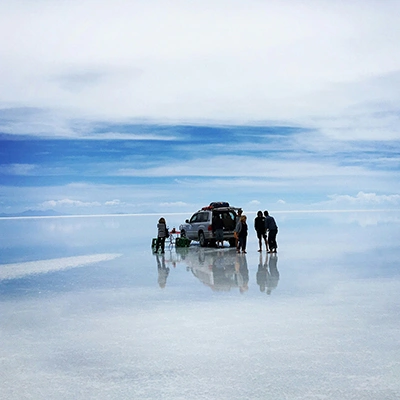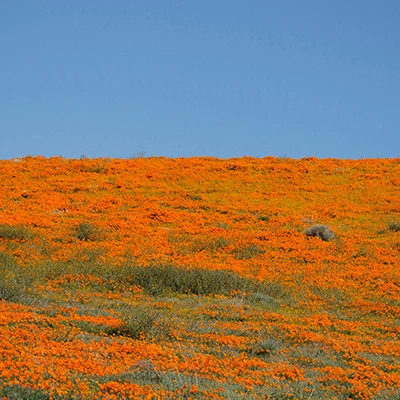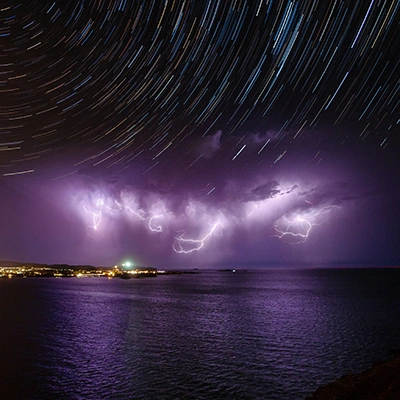Sometimes the best tourist attractions are ones that occur naturally. From the Aurora Borealis in the sky to flammable ice bubbles underwater to animal migrations across land, Mother Nature has provided us with some amazing natural phenomena worth traveling to see.
Flammable Ice Bubbles in Canada
Ice shouldn’t catch fire, right? In Albert, Canada, at Lake Abraham, it does ... kind of.
When naturally occurring methane floats to the surface of the lake, the bubbles are typically released into the atmosphere. During the cold Canadian winters, though, those bubbles become encased in ice.
Frozen yet flammable bubbles fill the water to create a surreal lake view. Mountains surrounding Lake Abraham add to the dramatic scene.
The best time to see the flammable ice bubbles is typically in January or early February, although the exact peak dates depend on weather conditions.
 Bolivian Salt Flats
Bolivian Salt Flats
You’ve probably heard of the Bolivian salt flats, but did you know that during the rainy season, the flats turn into a massive natural mirror?
An ultra-thin layer of water on the Salar de Uyuni reflects the sky, creating a bit of an optical illusion. During the day, you’ll see clouds and blue sky mirrored back from beneath your feet. And at nighttime, you might see the Milky Way bouncing back, so vivid it feels like you can touch it.
The views, above and below, are made all the more intense by the fact that you’re at high altitude with little light pollution.
The best time to visit the Salar de Uyuni if you want to see the mirror effect of the rainy season is from December to April.
Monarch Butterfly Migration
The monarch migration is one of the most well-known natural phenomena in North America and for good reason. Twice each year, you can catch half a million butterflies making their way some 3,000 miles from central Mexico to Canada and back again.
These small but colorful beauties congregate in trees during their migration — sometimes tens of thousands in a single tree — and create cloud-like formations en route.
There are a few places to see the migration at its finest. You can head to Michoacán, Mexico, in February where the monarchs are preparing to winter over. Santa Clara and San Diego, California, have similar climates, so you should be able to see the winter migration on the U.S. side of the border as well.
Serengeti Migration
The great migration in Serengeti National Park is an incredible time to take a safari. You’ll see millions of wildebeest traverse Tanzania in search of food and avoiding the dry season. About half a million of those are calves.
Covering about 500 miles, the event is the world’s largest mammal migration. Because it covers so much ground over so much time, it can be difficult to figure out the best time to see the wildebeest migration. You might see herds in northern Ndutu in January or the Serengeti Mara area on the border with Kenya in July.
Booking a trip with a local safari company can improve your odds of experiencing this epic event. Even if you don’t get the timing exactly right, you’re bound to still have an amazing animal adventure.
California Super Bloom
As one of the most unforgiving deserts in the world, Death Valley wouldn’t have much in the way of flowers, right? Every spring, though, you can find a brief burst of color when the wildflowers bloom in full force.
Occasionally — about once every 10 years — that burst becomes even more impressive. When autumn rainfall is particularly high, you’ll get a super bloom come April. The last Death Valley super bloom was in 2016.
See the more “regularly scheduled” California super blooms throughout the Golden State. In February, make your way to Mount Diablo State Park east of San Francisco, featuring more than 400 species of wildflowers. In March, try Chino Hills State Park outside Los Angeles, known for its California poppies.
There’s also Calero County Park in northern California, Anza Borrego Desert State Park farther south, and a whole host of other destinations, making choosing where to see the California super bloom a harder decision than you might think.
Cherry Blossom Festivals
The most iconic cherry blossom festivals are usually considered to be in Japan. As we pointed out in our list of best events for travel, Fuji Five Lakes in Chubu, Japan, is a favorite.
It’s not just about gazing at these romantic pink-blossomed trees, though. Traveling to Japan from March to May also gives you the opportunity to experience Hanami traditions, which include picnicking, parades, and other entertainment scheduled in homage to the cherry blossom trees.
Japan gifted 3,000 cherry trees to Washington, D.C., more than a century ago. Visitors to the U.S. capitol are still enjoying this sign of friendship with the National Cherry Blossom Festival every spring, usually in late March and early April.
Perseid Meteor Shower
Quick science lesson: When comets get too close to the sun, they heat up and break into pieces. Those pieces sometimes hit the Earth’s atmosphere at super high speeds. If they vaporize, they create a trail of light and what we see is a meteor shower.
The Perseid meteor shower is the result of debris coming off a particular comet that follows a regular path around the sun, making it a predictable natural phenomenon. With the right conditions for visibility, you can typically see this meteor shower from mid-July to late August with peak viewing time coming in mid-August.
For the best conditions, you want to go somewhere with little to no light pollution and few clouds. Although this could be any number of destinations, one popular spot is Tenerife, the largest of Spain’s Canary Islands.
Tenerife is home to Mount Teide, the highest peak in Spain which is also surrounded by a national park. You and all the other stargazers won’t be disappointed by a summer trip to El Parque Nacional del Teidi.
Northern Lights
Few natural phenomena look more mystical than the Aurora Borealis, or Northern Lights. As the name suggests, you can see this lightshow in the northern-most regions of the world, particularly Norway, Iceland, Greenland, and Canada.
The best time to see the Northern Lights is whenever the sky is super-dark and clear, although you also need the right solar activity (the colors are a result of solar particles ionizing in the Earth’s atmosphere).
Iceland gets just four to five hours of sunlight in January, which is one of the reasons it’s such a popular destination to see the Aurora Borealis. The winter weather can be unforgiving this time of year, though. If you brave the cold, be prepared for tour cancellations and road closures.
Some Norwegian cruises can take you to hard-to-reach places, offering a unique experience where you not only get to see the Northern Lights at their peak, but you also visit hidden gems of Scandinavian culture along the way.
Southern Lights
If you desperately want to see the Northern Lights but can’t handle those frigid temperatures, then you need to book a trip to see the Southern Lights, or Aurora Australis, instead.
The same natural events that create the Northern Lights also create the Southern variety. The Aurora Australis can be just as unpredictable as its northern cousin, too, but for a good chance to see Mother Nature’s showcase, try Tasmania in late March or September, in time for the seasonal equinoxes.
Queenstown, New Zealand is another hot spot, as you can see in this time-lapse video of Southern Lights activity.
Morning Glory Clouds
Unless you’re a meteorology buff, we wouldn’t blame you for never having heard of morning glory clouds. These tubular cloud formations are most often found in northern Queensland, Australia, off the Gulf of Carpentaria.
They look like someone rolled a cloud in a long, skinny net and then stretched it out over 60 miles. The phenomenon comes from conditions that are favorable to glider pilots, but simple cloud-spotting from the ground isn’t bad, either.
Make your way to Queensland at the end of the dry season – typically September to November – to see the clouds at their best. And don’t forget to set your alarm. You’ll need to get up early to catch these morning glories.
Travel Insurance for Mother Nature’s Unpredictability
Mother Nature puts on some amazing shows around the world. She can also make travel more difficult and cause us to change our plans unexpectedly. Protect your trip against the unpredictability of weather and natural disasters with travel insurance.
Talk to a licensed agent about how our plans can provide coverage for trip cancellation, delays, and more in the event of inclement weather. You can also get a quick quote online and learn more about your plan options at SevenCorners.com.
Travel Like a Pro with The Wayfinder
Did you enjoy this blog? Get more articles like it before anyone else when you subscribe to our monthly newsletter, The Wayfinder.
Sign me up


